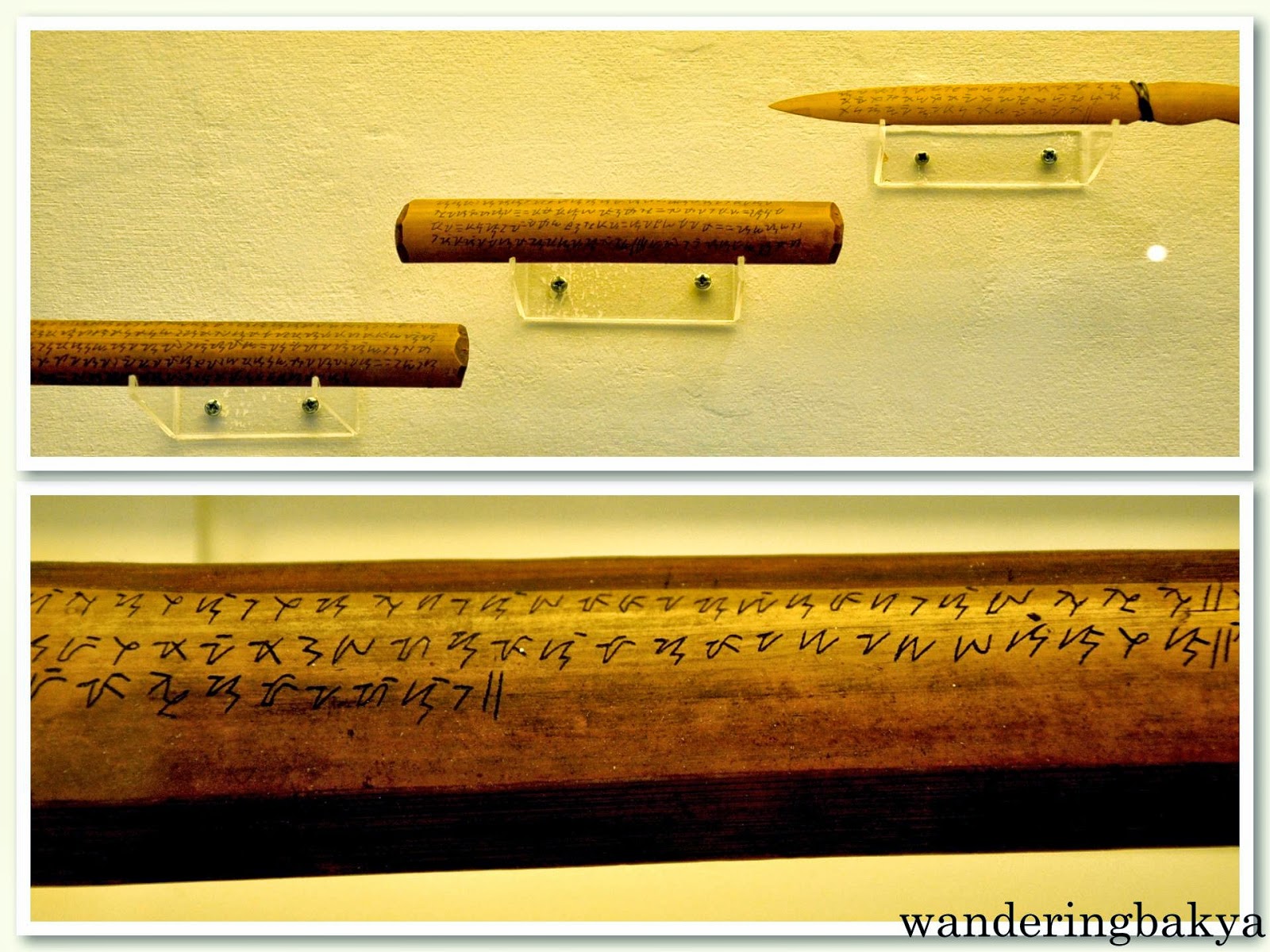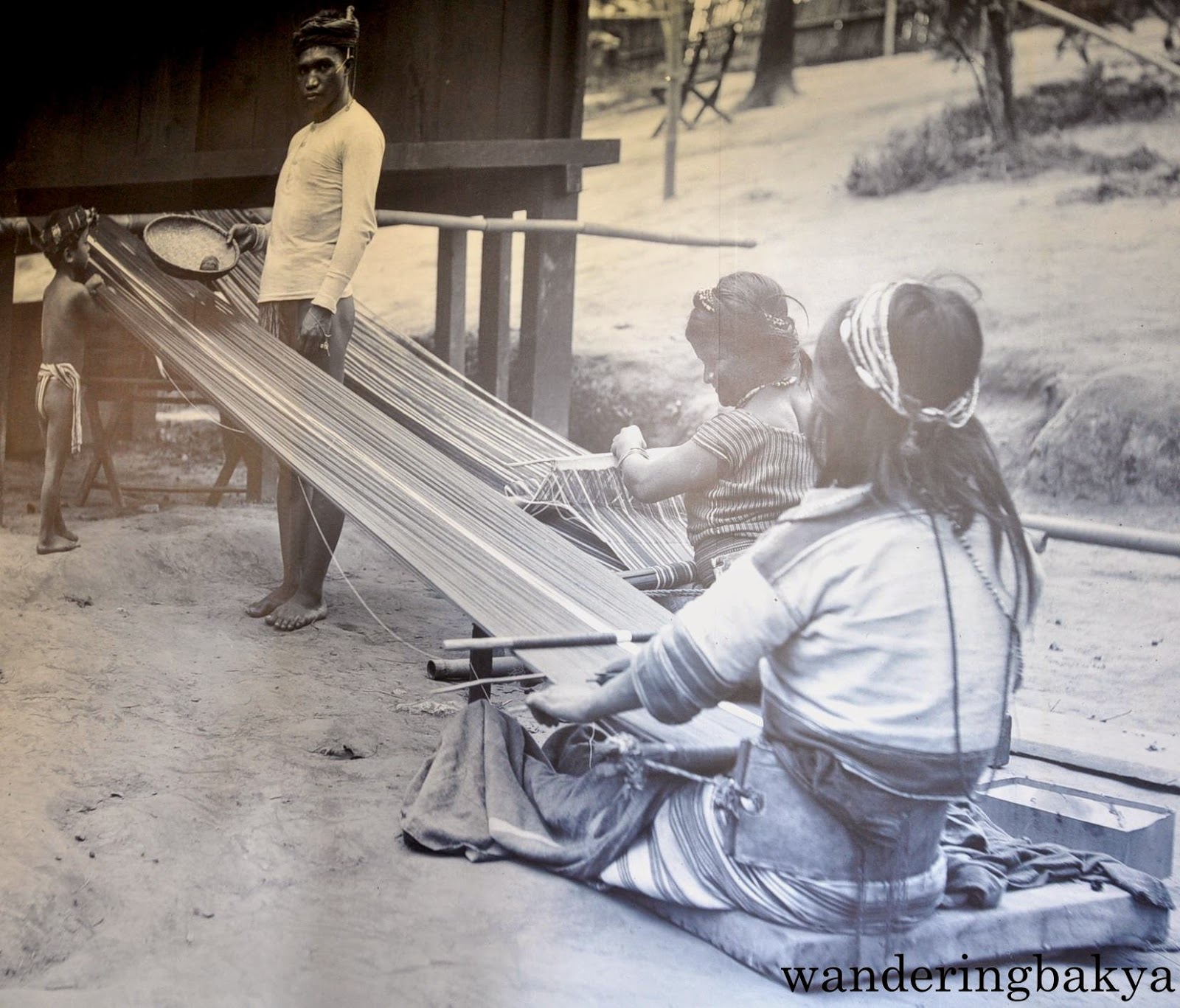The tour of The Museum of the Filipino People continues with the fifth and last exhibit, The Filipinos and Their Rich Heritage. This exhibit showcases the creativity of the Filipinos in the midst of scarce resources and the formation of cultural diversity among the different regions caused by the rough terrain and the ubiquitous influence of water in the archipelago. This exhibit occupies the entire top floor of the museum, and the amount of traditional art is overwhelming.
Filipino Heritage
Guests are welcomed by a bahay kubo and a banca at the entrance of the gallery. The right side of the gallery contains bigger-than-life photos of ethnic people in the Philippines and some famous personalities (members of a band and a basketball player). At the far right of the room, one can find traditional musical instruments, ancient writing material and the Laguna copperplate.
 |
| Bahay kubo or nipa hut. This stilt house was the traditional dwelling in the Philippines. Today, despite some form of modernization in the country, it is not uncommon to find bahay kubo in the countryside. |
 |
| Traditional musical instruments from various regions in the Philippines (mostly in Visayas and Mindanao) |
 |
| A boat-shaped guitar played by T’boli (left) and Lute or Kusapi – a boat-shaped guitar played by the Pala’wan |
 |
| Xylophone or gabbang – a boat-shaped instrument with eight graduated plates |
 |
| Drums or tambol |
Aside from the obvious musical inclination, ancient Filipinos also developed the other side of their brain. They had an organized system of writing, which enabled them to communicate with their Asian neighbors.
 |
| Sample of Pala’wan syllabic writing (top) and tobacco container inscribed with Hanunuo script |
 |
| Laguna copperplate inscription |
The Laguna copperplate inscription shows the huge influence of Sanskrit on ancient writing, and more importantly, it shows the level of civilization in the islands before the arrival of colonizers. The words were not scribbled on the copper plate; rather they were embossed so they survived the centuries of wear and tear unlike most pre-Hispanic records in the Philippines that were obliterated by time.
The left side of the gallery shows the tools used in fishing and hunting. In addition to these, there are traditional male and female garbs and their adornments. It seems like men had the same number of (if not more) accessories as the women. It is interesting to note that they had container for specific items, and these containers are intricately detailed and skillfully made.
 |
| Bamboo traps and containers and metal weapon for deep-sea fishing |
 |
| Personal adornment |
 |
| Betel nut container or mamaan (Sibutu, Tawi-Tawi) and jewelry box (Tandubas, Tawi-Tawi) | |
The innermost part of the room is dedicated to Ifugao items. Aside from the photos included here, there are stools, day bed and other household items.
 |
| Chicken cage or ubi – Rattan cage used to secure their chicken |
 |
| Back pack or bango – Used by Ifugaos to carry food and personal items |
 |
| Granary Deity or Bulol – Standing human figure used during granary ritual. Bulol is placed on the entrance of the granary to guard the harvest |
 |
| It might be possible that this jar was used to hold rice |
Uniquely Filipino (Bukod-tanging Filipino)
This gallery gives prominence to baybayin, the pre-Hispanic writing system in the Philippines. Baybayin was largely used in Tagalog-speaking areas, but it gained more prominence when it was used and spread by the friars to other areas. It is an abugida system wherein consonant-vowel combinations are used, and it is different from alibata (although most people think they are one and the same). Hanunuo, Buhid and Tagbanwa are some of the writing systems that are based on baybayin.
 |
| Baybayin: only in the Philippines |
 |
| The Laguna copperplate inscription is said to be one of the bases of baybayin |
 |
| Estudio de los Antiguos Alfabetos Filipino by Fr. Cipriano Marcilla (left) and La Antigua Escrita Filipina by Don Ignacio Villamor |
 |
| Doctrina Christiana by Fray Juan de Plasencia |
Doctrina Christiana is widely believed as the first ever book printed in the Philippines. It contains Christian teachings and was used to promulgate the Ten Commandments, prayers like The Lord’s Prayer and the Articles of Faith. It was printed in Tagalog and in baybayin.
 |
| Inscription on bamboo strip |
Musical instruments, containers and weapons were inscribed with chants and messages. These bamboo strips were used to relay messages among members of Hanunuo and Buhid. Messages include invitation to wedding and special occasions and letters of request and notification, which were carried by anyone passing by or going to the destination of the message.
 |
| Bamboo lime container or apugan with inscription |
The members of Hanunuo, men and women, had an average of 4 bamboo lime containers. They were responsible for making, carving and designing their own container. Male young adults used to give bamboo lime containers to the females they admired and wished to be in a relationship with.
 |
| The Monreal stones were discovered in Masbate and they show the ancient inscription or baybayin. There are two Monreal stones in the museum; the photo shows the bigger one. |
The Artistry of Philippine Textiles (Hibla ng Lahing Filipino)
 |
| Ifugao family wearing their traditional garment |
This gallery features the traditional method of weaving clothes, traditional clothes from different regions in the Philippines and how some garments are used in funerary rites.
 |
| Baro at Saya with Pañuelo (Negros Oriental) – The baro or upper garment is made of sinamay abaca with embroidery and beads while the saya or the skirt is piña |
 |
| (bottom part of photo from left to right) Batling, calipan and ginuttu |
Batling is Ilongot male earrings made of hornbill beak, nautilus shell/mother-of-pearl and brass. Batling was worn by Ilongot headhunters to signify their courage and skill. Calipan are female earrings composed of mother-of-pearl and brass, worn by Ilongots from Quezon Province. Ginuttu is a belt made of shells and coconut shells worn by local chiefs and wealthy Ifugao males.
There are around a dozen looms inside the gallery. These looms are from various parts of the country, as far as Ilocos in the north and Cotabato in the south. The presence of looms and the beautiful garment that are produced by these contraptions enabled my ancestors to dress to the nines.
 |
| Looms from different regions |
 |
| Backstrap loom or ablon (Davao/Mandaya) |
 |
| Foot loom or tilar/pang-abelan (La Union/Ilocano) |
 |
| Wood and metal spinning wheel or gilingan (Lanao del Sur/Maranao) |
 |
| A photograph that was displayed in the 1904 St. Louis World Fair: suyoc weaving |
There are exquisite traditional garment that are bursting with colors. My favorites are the ones from Iloilo (of course), Abra and Davao. Aside from real materials, there are photos of local chiefs or datu wearing their traditional clothing.
 |
| Female upper garment traditionally worn by Ilonggos (Iloilo) |
 |
| Jacket or bado worn by Tinguian or Ifugao. This upper garment is made of beaten bark and embellished with embroidery, paint and cotton balls (Abra) |
 |
| This female upper garment is an example of albon. It has shell discs and beads and comes in the traditional colors of red and black. B’laan women of Davao wore albon during special occasions. |
 |
| Clothes of a B’laan Datu (left) and traditional clothes from South Cotabato |
 |
| Replica of 19th century Mandaya costumes which includes dagum or intricately embroidered top, dagmay or tubular skirt, payutgut or tight choker worn on the neck, balyug or breastpiece made of woven beadwork, and tungkaling or a waist piece made of beads, among other things. |
Environment
I cannot remember the name of this gallery, but it is all about the environment. There are stuffed animals that are either extinct or are endangered. There are several species of corals and other flora and fauna that are endemic to the Philippines.
 |
| Sarus cranes and Philippine monkey-eating eagle |
Sarus cranes used to be abundant in Candaba marsh and Cagayan River valley. The only species of cranes that breed; Sarus cranes belong to an extinct species of birds. The Philippine monkey-eating eagle is an endangered species that the Philippine government tries to protect from extinction.
 |
| Spot-bellied pelican |
Spot-billed pelican is the only species of pelicans found in the Philippines. There were plenty of sightings of spot-billed pelican in Candaba marsh, Pampanga, Tarlac and Laguna. Now, like the sarus cranes, this species of pelican has been declared extinct.
 |
| Luzon Tarictic Hornbill |
Pagkaing Filipino (Philippine Amusement and Gaming Corporation Gallery)
 |
| This room contains photos of native Filipino delicacies |
 |
| Rice delicacies and roasted pig or litson |
The Antonio and Aurora Tambunting Gallery and The Villonco-Samson Gallery
The last gallery is all about rice. There is a short history of rice cultivation in the Philippines, different art pieces that feature rice, the different species of rice, the numerous tools used in farming and the religious aspect of farming.
 |
| Farming tools that include but not limited to mortar or luhong and pestle (used for pounding husked rice), harrow and plow. |
 |
| Rice variety in the Philippines |
 |
| Water buffalo or carabao figure by Mariano Edjawan |
 |
| Planting Rice by Norris Castillo (Oil on canvas). This painting has a remarkable size, measuring 3cm by 33cm. |
 |
| Harvesting – Harvesting by Norris Castillo (Oil on canvas). This measures 0.64cm by 0.95cm! With the help of magnifying glass I can see a couple of red dots against a gold background. |
The Museum of the Filipino People is in Agrifina Circle, a stone’s throw away from the National Gallery and Rizal Park. It is open Tuesdays to Sundays from 10:00am to 5:00pm. It is closed on Mondays and public holidays. Regular admission price for adult is P150 (US $3.46), senior citizen with ID, P120 (US $2.77), student with ID, P50 (US $1.15) and children below four years old get in for free. Entrance is free to all visitors on Sundays. Gallery tours are available, just contact Museum Education at (02) 527-0278 or at (02) 527-1215.
For more information, please visit
www.nationalmuseum.gov.ph.































































0 comments:
Post a Comment
message comment